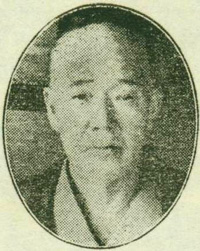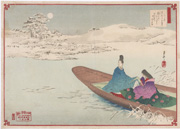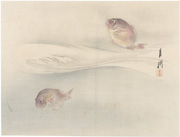Prints in Collection
Illustration of the Viewing the Captured Chinese Warship Chinen at Yokosuka
Naval Port, 1895
IHL Cat. #529
-intentionally left blank-
-intentionally left blank-
Young Sea Bream
from the book Gekkō Gahō, 1899
IHL Cat. #1812
Biographical Data
Biography
Ogata Gekkō 尾形月耕 (September 15, 1859 - October 1, 1920)
Sources: website of Robert W. Turley http://ogatagekko.com/Site/Biography-669.html (note Turley's site is now inactive); Woodblock Kuchi-e Prints: Reflections of Meiji Culture, Helen Merritt and Nanako Yamada, University of Hawaii Press, 2000, p. 211-214; and as footnoted.
 Artist at age 60 | Early YearsOgata Gekkō was born Nakagami Masanosuke (名鏡正之助), also known as Tanaka or Tai Masanosuke (田井正之助), in Saemon-cho in the Kobayashi district of Edo (modern day Tokyo), and lived most of his life in the Kobayashi district in Oke-cho. His father Nakagami Seijiro was a rich tradesman who, along with Gekkō's grandfather Nakagami Chobei, ran a temporary employment agency for sovereigns, the rich nobility and rich merchants. Gekkō was orphaned at the age of 16 when his father died and his family lost their businesses and had to open a lantern shop. The teenage Gekkō survived by decorating rickshaws and selling his drawings. It didn't take long for his exceptional artistic talent to be recognized. Ogata Koya adopted him and the young artist appended their family name to the name he gave himself, Gekkō, which means 'Moonlight'. Marutani Shinhachi, a publisher and Gekkō's patron early in his career, encouraged the artist with financial assistance and helped get him a job as a hanshita artist for Azuma shinshi (New Azuma Magazine.) Kawanabe Kyōsai (1831-1889) noticed his talent and recommended that he draw triptychs related to current events. |
A Self-Taught Artist
In 1885, his art career took a big leap forward when he exhibited a painting in the first exhibition of the Japanese art association Kanga Kai, founded by the influential art scholars, Ernest F. Fenollosa and Okakura Tenshin (aka Okakura Kakuzo), who would become regular visitors to Gekkō's home.Though Gekkō would later become a founding member and developer of several important art institutions, including Nihon Bijutsu Kyōkaï (Japan Fine Art Association), Nihon Seinen Kaïga Kyōkaï (the Japan Youth Painting Association), the Academy of Japanese Art, the Bunten (the Ministry of Education's annual juried exhibition), and an actively participating member of the Nihon Bijitsuin (Japan Fine Art Academy) and the Meiji Fine Art Association, he never attended art school himself, nor did he undergo the traditional apprenticeship in a print maker’s studio. In a society that discouraged self-promotion, Gekkō began his art career by preparing flyers and taking them around to various publishers and places to sell his services as an illustrator for magazines and newspapers and a designer of lacquerware and pottery.
Unique Style
While carvers and printers required clear lines and separated colors from print designers. Gekkō defied these requirements. Because he began his career as a painter and illustrator, and was a self-taught artist unburdened with the rules of print making, many of his prints achieved a painterly look that was thought impossible for prints. They have the illusion of brushstrokes, the colors blend into each other and are awash, and the perspectives are unique to Gekkō1. Gekkō is credited, along with Watanabe Seitei (1851-1918), with developing the sashiage technique, which simulates watercolor effects in woodblock printing. This singular style of his is well realized in his series of triptychs, Bijin Meisho Awase (Beautiful Women in Famous Places), and reached its highest expression later in his career with his series, Fuji hyakkei (100 Views of Mount Fuji), and in many of the shishikiban (square format) prints that were also from the later part of his career.His Prints
Gekkō chose a great variety of subjects for his prints, from everyday life in the streets and homes of Japan and serene nature prints with their highly detailed bird plumage, to the violence of war in prints that he designed working directly from his sketches as a war correspondent during the Sino-Japanese War (1894-95). While other print artists turned out workmanlike war prints, Gekkō created artistic prints that conveyed the horror and emotions of war.Although his techniques were thoroughly modern, Gekkō considered himself to be firmly rooted in the ukiyo-e tradition. One of his first series of prints published in 1890 was titled Ukiyo Junikagetsu (Twelve Months of Ukiyo). Also in the ukiyo-e tradition, he made a Tale of Genji series and a 47 Ronin series of prints. Other print series he designed were: Gekkō Manga (a popular series on contemporary practices); Gekkō zuihitsu (Gekkō Miscellany); Hana bijin meisho awase (Beauties and Flowers at Famous Places); Bijin meisho awase (Beauties Matched with Famous Places); Fujin fuzoku zukushi (Manners and Customs of Women); Nihon no hana zue (Pictures of Flowers of Japan).
His Students
Though he had no teacher himself, he had some outstanding pupils during a 30 year teaching career, including Yamamura Toyonari (1885-1942), his son Ogata Getsuzan, Kanamori Nanko, Sakata Kosetsu, and Tsukioka Kōgyo (1869-1927), whose mother had married the Meiji Period’s other great artist, Tsukioka Yoshitoshi (1839-1892).His student Yamamura Toyonari wrote that Gekkō "lived in Okecho in his native Kyobashi in a fine house once occupied by the kabuki actor Ichikawa Yaozō." In addition to visits by Fenollosa and Okakura Tenshin, artists such as Terasaki Kōgyo, Mizuno Toshikata (1866-1908), and Tomioka Eisen were frequent visitors. Toyonari reported that Gekkō received one yen for a hanshita for a manga and fifteen to eighteen yen for a painting. Rent for his house was six yen.
Awards and Recognition
Gekkō won both domestic and international awards, such as at the 1893 and 1894 Kyoshin Kai (1st and 3rd place medals, respectively for his paintings Chigo Yugizu and Kibeki zu) and at the 1896 and 1897 Japanese Art Association (Nihon Bijutsu Kyokai) competitive exhibition (1st and 3rd place medals, respectively for his paintings Hichi Yume and Yoshi-iye) and internationally at competitions in Chicago (1893 Columbus Exhibition for his painting A Festival of Sanno at Yedo), Paris (the 1900 Paris Exposition), 1904 World Fair in St. Louis, and London (the 1910 Japan-British Exhibition). In 1898 Emperor Meiji purchased his painting Soga Yato.Gekkō had the good taste and higher artistic sense to mostly avoid many of the gaudy trends that were exploited by other, more popular print artists of the Meiji Period, such as the heavy use of bright red and purple dyes.
Death
Ogata died on October 1, 1920 and is buried at Zoshigadani cemetery, Toshima-ku, Tokyo.2Artist Names (gō)
Source: A Dictionary of Japanese Artists: Painting, Sculpture, Ceramics, Prints, Lacquer, Laurance P. Roberts, Weatherhill, 1976, p. 123.
Gekkō (月耕); Kagyōsai (華暁斎); Meikyōsai (名鏡斎); Nen'yū (年邑); Rōsai (斎楼)Signatures (a sampling)
For a more extensive sampling of signatures see the website of David Humphries http://www.ogatagekko.net/
 Gekkō with Ichigaku ichiei seal, 1895 |  Gekkō with round Kagyōryō shujin seal, 1894 |  ōju gekkō (by special request) with square Kagyōryō seal, 1895 |  月耕 /月耕 Gekkō with gourd shaped Gekkō seal, 1895 |  月耕 /月耕 Gekkō with rectangular Gekkō seal | -signature-150h-web.jpg) Gekkō signature from painting with Miei seal |  Gekkō signature from painting with Konchū Tenru seal |  月耕 / 尾形 Gekkō / Ogata |
2 The Sino-JapaneseWar, Nathan Chaikin, self-published, 1983, p. 36.








